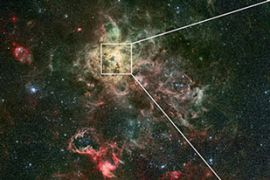Biggest known star discovered
The ‘monster’ star has a mass of about 300 times that of the sun.

“To put that into perspective; the nearest star to our sun is only four light years away,” Dr Parker, expert on the evolution of star clusters, said.
Scientists say the star, called R136a1, may have been as large as 320 solar masses when it first formed, but has shed some of its initial mass over time.
Dr Parker said the find was “incredibly significant” because it has changed scientists’ understanding of how massive it is possible for a star to be.
“Until recently people assumed that there was a fundamental upper limit to how massive a star could be and that upper limit was 150 times the mass of our own sun, which in itself is quite large,” he said.
The star was the most massive of several giants identified by the team of scientists.
While other stars can be larger, notably the swollen crimson-coloured ones known as red giants, they are far less heavy.
The mass of the stars in the R136a cluster means they are tens of times bigger than the Earth’s sun and brighter and hotter too.
Surface temperatures can surpass 40,000 degrees Celsius (72,000 degrees Fahrenheit), seven times hotter than the sun.
They’re also several million times brighter, because the greedy giants tear through their energy reserves far faster than their smaller counterparts.
Live fast, die young
That also means that massive stars live fast and die young, quickly shedding huge amounts of material and burning themselves out in what are thought to be spectacular explosions.
Small lifespans are one of several reasons why these obese stars are so hard to find.
Another is that they’re extremely rare, forming only in the densest star clusters.
Astronomers also have a limited range in which to look for them.
In clusters that are too far away, it isn’t always possible to tell if a telescope has picked up on one heavyweight star or two smaller ones in close proximity.
In this case, the team re-examined previously known stars to see if they could find an accurate measurement of their mass.
The team reviewed archival data from the Hubble Space Telescope and gathered new readings from the ESO’s Very Large Telescope.
Parker said “cutting edge instrumentation” on the VLT had enabled the team accurately to determine the mass of these stars for the first time.